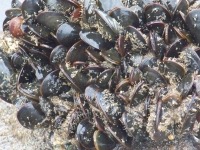
(Photo: Tracey Dean)
Blue Mussel
Mytilus edulis
Blue mussels are smooth-surfaced and roughly pear-shaped bivalves. Their outer shell ranges from glossy blue to bluish-black and sometimes pale brown with rays. They have brown, tough fibres, called byssal threads or the "beard." The beard extends out from between the shells, allowing them to attach to the substrate on the bottom. The inside of the shell is often violet in colour. The soft tissue colour can determine sex. Females show pink to orange colouration, and males show a cream colour. They average in length from five to ten centimetres. The largest specimens recorded were 15 to 20 centimetres in length.
Authority
Linnaeus, 1758
Classification Details
Phylum: Mollusca (molluscs); Class: Bivalvia (bivalve molluscs).
Habitat
Blue mussels have a circumpolar distribution. In the western Atlantic, their range extends from the Maritime Provinces of Canada down to South Carolina in the USA. They are common in the Bay of Fundy. They are often attached to rocky shores in the intertidal and subtidal zones. They form dense masses. Found along rocky coastlines, bays, mouths of rivers, sheltered harbours, and estuaries. They occur in both brackish and fully saline environments.
Diet
Suspension feeders. Mussels capture food by filtering it out of the water. Cilia (microscopic hair-like structures) inside the mussel create a current that pulls in water. Particles are then trapped in food grooves and transported to the mouth. Diet includes bacteria, phytoplankton, detritus, and dissolved organic matter.
Reproduction
Sexes are usually separate, but some individuals can be hermaphroditic (both male and female). They reach sexual maturity in late spring or early summer when sperm and eggs develop. Fertilization is external. Males release sperm, which in turn triggers egg release into the water column. Changes in temperature, food levels, and physical disturbances determine when spawning occurs. Larvae undergo several stages of metamorphosis. Fertilized eggs develop into ciliated embryos. Within 24 hours, they give rise to trochophore larvae. This is a free-swimming stage, that does not feed. Trochophores transform into the veliger stage (also referred to as spat). They develop ciliated fan-like protrusions to aid in movement and begin suspension feeding. This lasts about 35 days, during which they develop pigmented eyespots, the shell, and the foot. The foot attaches to substrates such as filamentous algae, hydroids, or rocks. It remains there until it reaches about 1 to 1.5 millimetres in length. It then detaches and drifts to the bottom where it re-attaches to the substrate using secreted byssal threads.
Fun Facts
Blue mussels can form dense beds on the sea floor, which can be up to five or six layers deep.
References
DFO. Profile of the Blue Mussel (Mytilus edulis) Gulf Region. https://waves-vagues.dfo-mpo.gc.ca/Library/270029-e.pdf Accessed online 22 January 2020.
NOAA. Blue Mussel − Mytilus edulis – Office of Science and Technology. https://www.st.nmfs.noaa.gov/Assets/ecosystems/climate/images/species-results/pdfs/Blue_Mussel.pdf Accessed online 22 January 2020.
Tyler-Walters H (2008) Mytilus edulis Common mussel. In Tyler-Walters H. and Hiscock K. (eds) Marine Life Information Network: Biology and Sensitivity Key Information Reviews, [on-line]. Plymouth: Marine Biological Association of the United Kingdom. Available from: https://www.marlin.ac.uk/species/detail/1421 Accessed online 22 January 2020.
Zagata C, Young C, Sountis J and Kuehl M (2008) Mytilus edulis Animal Diversity Web. https://animaldiversity.org/accounts/Mytilus_edulis/ Accessed online 22 January 2020.


